Best Pole Saws for Tree Trimming
In our search for the best pole saws to make tree trimming easier and more efficient, we have carefully evaluated numerous models for reach, power, and ease of use. Our selection is tailored to cater to both professional landscapers and DIY garden enthusiasts, ensuring that you find a reliable tool that meets your specific tree maintenance needs.
Top Pole Saws for Tree Trimming
1. DEWALT Cordless Pole Saw
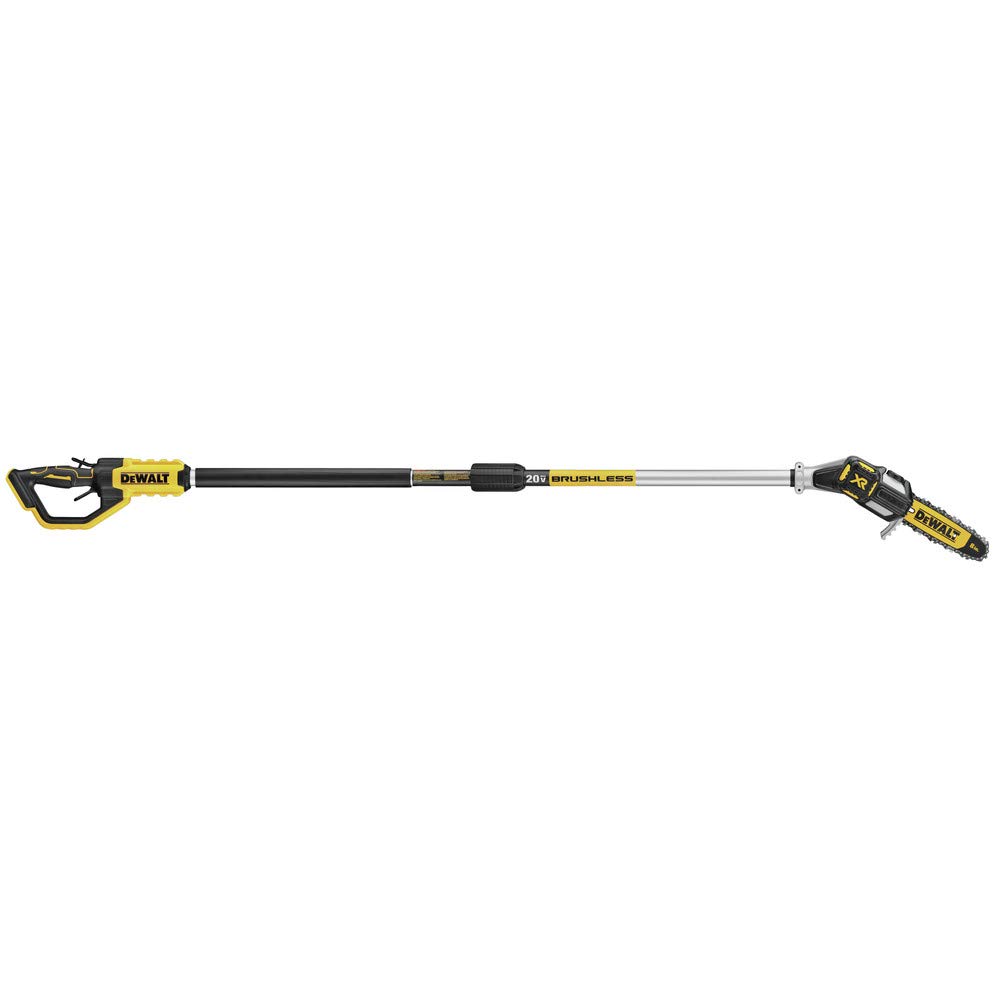
After taking the DEWALT Cordless Pole Saw for a spin in the backyard, we were struck by its balance and ease of operation. Starting with the setup, it was straightforward and we quickly became accustomed to the tool’s features. The auto oiling function is a highlight, as it kept the chain running smoothly without the need to manually lubricate, saving us precious time on the task.
Pros
- Exceptional overhead reach, making high cuts more manageable
- Brushless motor maximizes efficiency, doing more on a single charge
- Auto oiling ensures continuous and smooth operation
Cons
- Top heaviness can be challenging with full extension
- Exclusively compatible with DEWALT batteries and chargers, not included
- Flexible pole can feel less sturdy when fully extended
Handling the saw, even at its full extension, gave us the advantage of dealing with otherwise hard-to-reach branches. Despite noticing some top heaviness at full reach, this was a small trade-off for the convenience of not needing a ladder. Comfortably standing on the ground and accessing 15 feet up into our trees transformed what used to be a cumbersome task into a more pleasant chore.
The efficiency of the brushless motor didn’t go unnoticed. We were able to make numerous cuts through sizes up to 4 inches without any slowdown in performance. However, users should note that the flexibility of the pole might require a little more control during extended use. Despite this, the tool is comfortable to handle, and we appreciate how the metal bucking strip and tree hook facilitated easy removal of cut limbs.
Overall, our experience was positive. While ideally, the kit would include a battery and charger, being part of the DEWALT ecosystem means that if you already own their 20V MAX* batteries, this pole saw becomes even more valuable as part of your yard maintenance arsenal.
2. WEN Electric Pole Saw
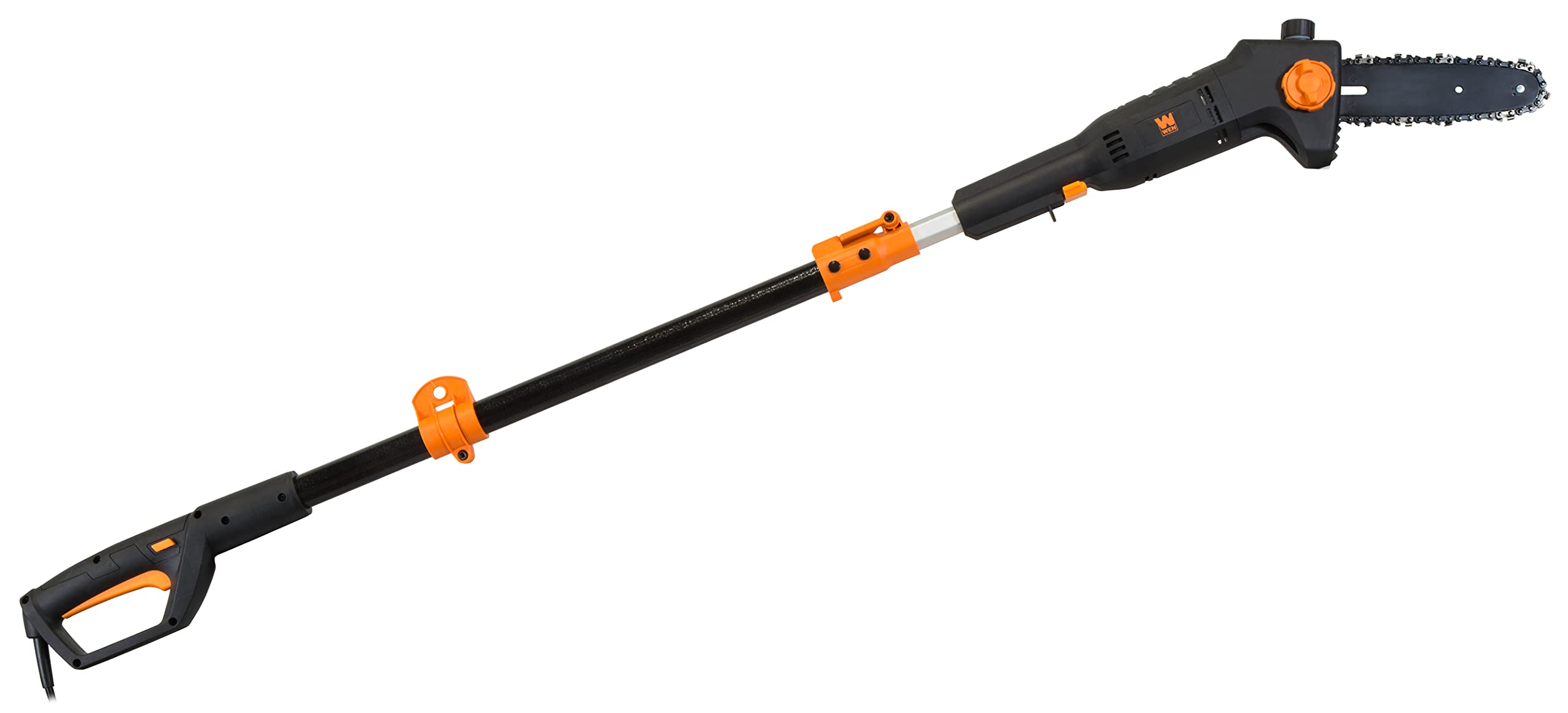
If you’re in the market for an environment-friendly pole saw that’s light and simple to operate, we reckon the WEN Electric Pole Saw is a choice worth considering.
Pros
- Powerful cutting without emissions as it operates without gasoline
- Extended reach with an adjustable telescoping pole
- Lightweight and comfortable during extended use
Cons
- Limited to power outlet accessibility due to being corded
- May not be suitable for very large or thick branches
- Usage can be hindered by the automatic oiling system if it malfunctions
Recently, we got our hands on the WEN Electric Pole Saw, and the convenience of adjusting the telescoping pole was apparent from the get-go. Transitioning from 5.3 to 7.3 feet allowed us to reach branches we previously couldn’t with other tools. It feels like your reach has been amplified, granting an unprecedented dominion over unruly tree limbs.
Weight is a critical factor when working above your head, and this saw’s light build minimizes strain, letting us work longer without fatigue. Coupling this with the shoulder strap provided a surprisingly comfortable experience, which could easily be overlooked but is essential for efficiency and safety.
When it came to performance, the saw managed to zip through several branches with ease. The 6-Amp motor handled most of what we threw at it, and the lack of a gas engine was a breath of fresh air—literally. The absence of fumes is not just a nod to environmental consciousness; it also makes working in enclosed gardens much more pleasant.
However, even the sharpest tools in the shed have their quirks. Being tethered by a cord can restrict movement, and while the harness supports a lot of the weight, at times maneuvering the saw can feel a bit clumsy, especially if you’re navigating around numerous obstacles. But, taking into account the overall utility and effectiveness, these are minor trade-offs for such a handy tool.
In short, the WEN Electric Pole Saw impressed us with a blend of reach, power, and user-friendly design. It’s not without limitations, but for the gardener who needs a reliable assistant in keeping their trees well-manicured, it stands out as a smart, eco-friendly option.
3. HOSKO 14FT Pole Saw
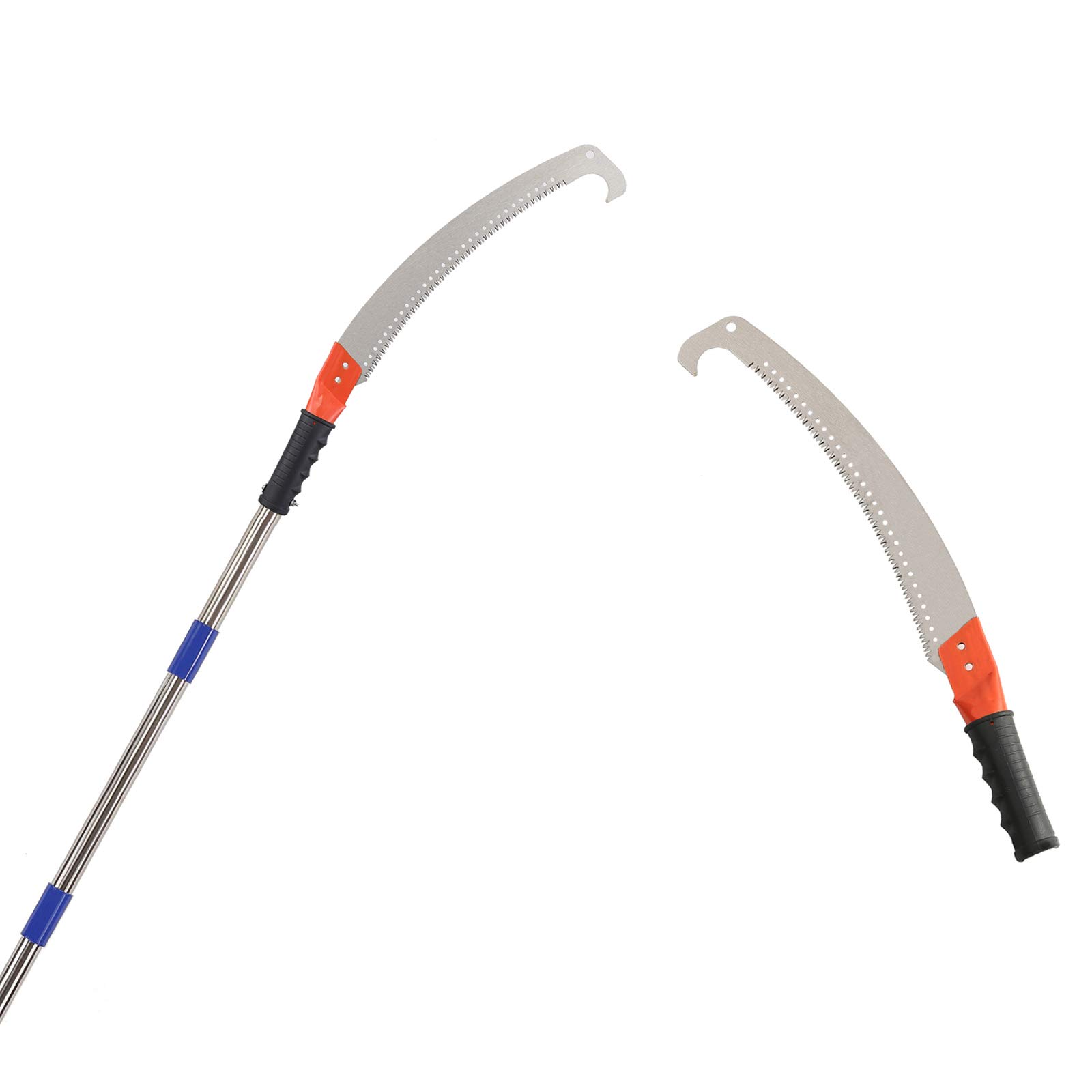
This is the best manual pole saw that we tried.
Pros
- Versatility with adjustable length reaching up to 14 feet
- Effortless cutting with sharp bi-directional blade
- Corrosion-resistant stainless steel construction
Cons
- Potential for blade flex due to length when fully extended
- Balance can be challenging with sections fully assembled
- Assembly and disassembly may be time-consuming for some users
After taking this pole saw out for a spin, it’s clear it’s built with the user in mind. Its ability to extend and retract on demand allows for a customizable reach. Whether you’re cutting high branches or shaping shrubs at a lower height, the adjustability is a real asset. Its ease of use shines when you slide the sections together, stretching out to lengths that rival that of a ladder.
We appreciated the stout sharpness of the blade as it made contact with the branches. It’s like having a professional-grade tool in your own backyard. Whether we faced off with small or moderately-sized limbs, the bi-directional cut of the saw bit through wood without much force needed—a true testament to its design for efficient cutting.
Handling the saw was mostly comfortable, except when fully extended – that’s when you feel some flex. This is not uncommon for such tools, but worth mentioning. In our time with the HOSKO Pole Saw, storage wasn’t an issue—its detachable sections took up minimal space, although putting it all back together for another round will eat up a few minutes of your time. One thing’s for sure: when it comes to maintaining your yard, this saw is an ally, simplifying what was once a daunting chore.
4. VEVOR Extendable Pole Saw
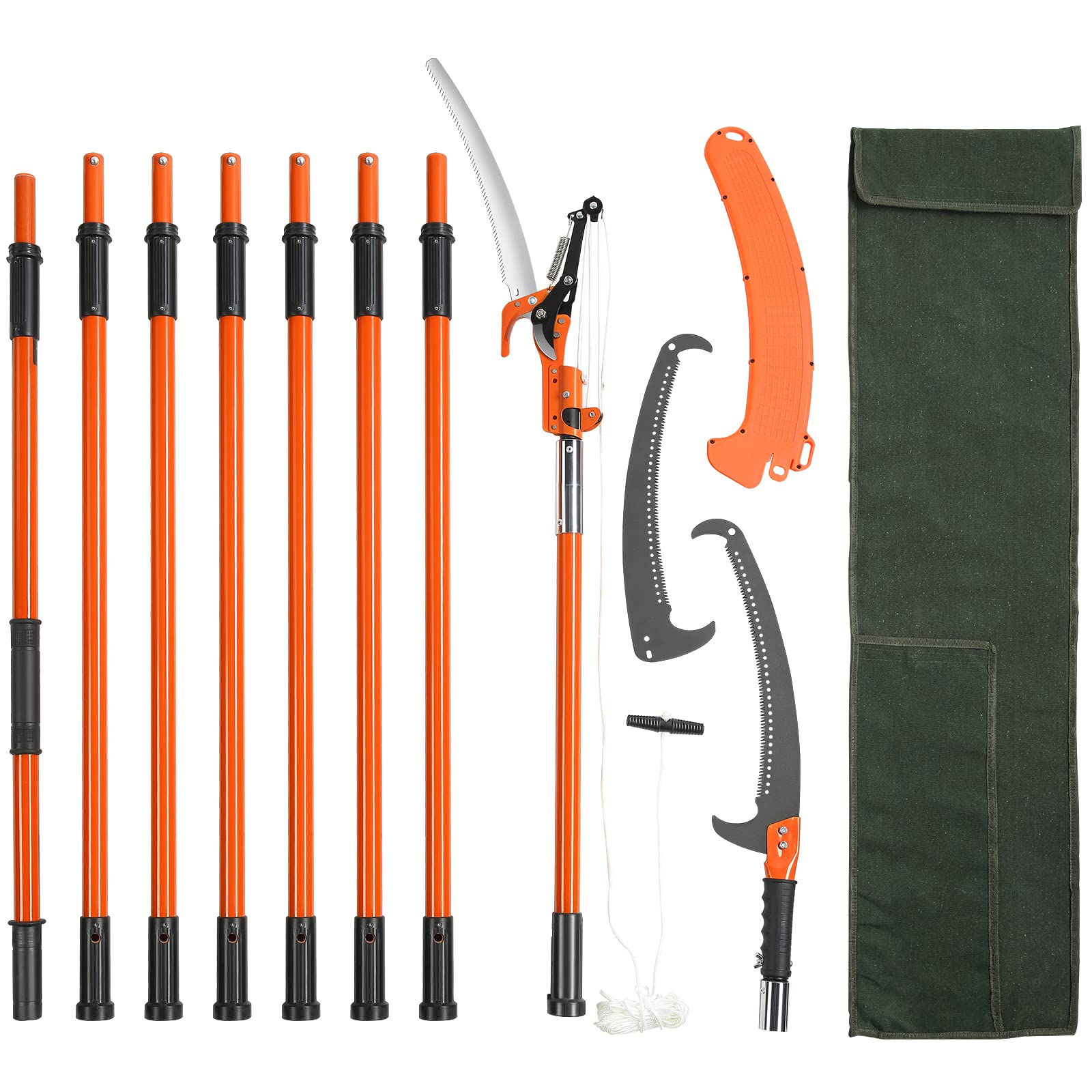
Pros
- Easily adjustable for heights, facilitating comfortable tree trimming from various angles.
- Lightweight with a double-lock design that contributes to a sturdy, safe experience.
- The blade’s Teflon coating maintains sharpness, enhancing the longevity of the saw.
Cons
- Full extension may feel a bit unwieldy for some users.
- Plastic threads may be less durable, posing a risk of breakage over time.
- Included blades may require frequent sharpening with heavy use.
As we maneuvered the VEVOR pole saw through the foliage, the height adjustability came in incredibly handy for those hard-to-reach branches. Whether we were angling precariously from a ladder or standing firmly on the ground, this saw adjusted to just the right length with a satisfying snap of the double-lock joints.
At just over 11 pounds, wielding this tool did not strain our arms, which was a surprising delight considering the amount of overhead work involved. The Teflon-coated blade sliced through branches like butter, and the added hook knives on either side made for efficient cut-and-pull action. It’s apparent that thought went into the design, focusing on what really matters: cutting power and comfort.
Storing the VEVOR was also stress-free. With all pieces fitting neatly into the provided storage bag, it was clear that our workspace remained organized, and the risk of misplacing any vital part of this trimming toolkit was minimal. After a full day’s work, we appreciated being able to pack everything up without a hassle, ready for the next pruning session.
5. Walensee 14 FT Pole Saw
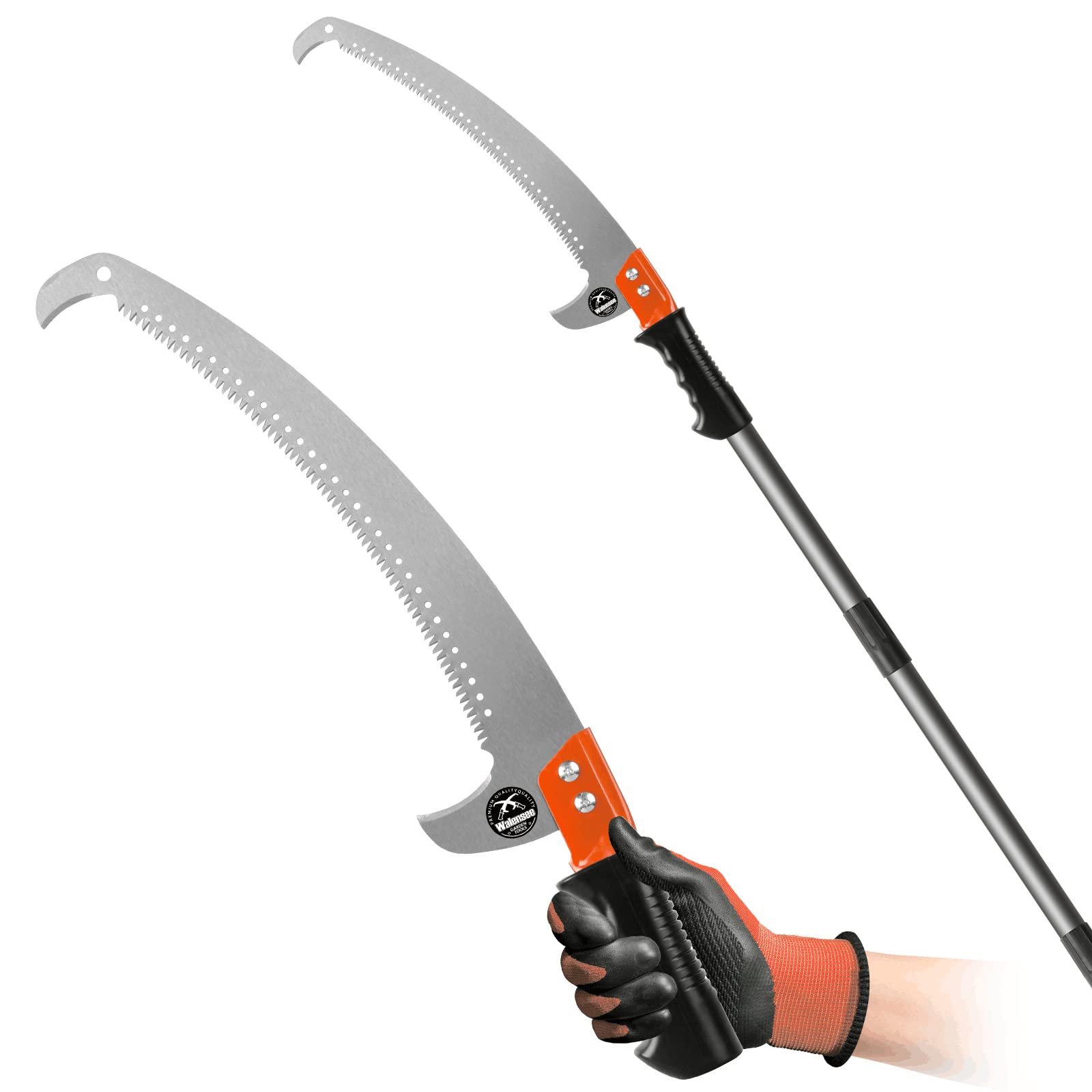
We recommend this Walensee pole saw for anyone needing to trim hard-to-reach branches, as it balances functionality with ease of use.
Pros
- Blade sharpness accelerates cutting
- Adjustable length enhances reach
- Comfortable grip reduces hand fatigue
Cons
- Potential for pole sections to loosen
- May flex under pressure
- Assembly required
When we used the Walensee pole saw to clear some overgrown tree limbs, the first thing we noticed was the blade’s sharpness. It slices through branches quickly, making our job less time-consuming and physically demanding. Trimming at various heights was no hassle because the pole’s length can be easily adjusted—extra reach without needing a ladder was a real bonus for us.
The pole’s reliable construction stood out too; it felt sturdy with every cut. Handling was quite manageable for extended periods, thanks to the comfortable grip. Even after a morning’s work reshaping a row of tall shrubs, our hands were not overly fatigued, which is a testament to the saw’s design.
However, we did notice the pole sections could loosen during use, needing occasional retightening, which interrupted our workflow. Also, with forceful strokes, there was some flex in the pole, so care is necessary to prevent potential bending. Finally, setting up the Walensee took us a bit of time, but once all sections were connected and the blade attached, the assembly held up well throughout our task.
How to Choose a Pole Saw for Trimming Trees
When selecting the best pole saw for tree trimming, consider the height and thickness of the branches you’ll be tackling, as well as how often you’ll use the tool. Weight and ease of use are also important, especially since handling a pole saw can be physically demanding. Features such as an adjustable pole length, a powerful cutting mechanism, and ergonomic design can greatly enhance efficiency and comfort during the task.
Safety should never be compromised when working with pole saws. Look for models with features such as non-slip grips, shoulder straps, and safety switches or locks to prevent accidental starts. Maintaining the saw’s chain tension and sharpness, as well as wearing appropriate protective gear, are also critical for safe operation.
Key Features to Consider
- Power Source: Decide between electric, battery, or gas-powered models based on the task’s requirements and mobility needed.
- Pole Length: Ensure the pole is long enough to reach high branches without overstretching, which might lead to safety issues.
- Weight: A lighter pole saw will reduce fatigue and make it easier to handle for extended periods.
- Blade Length: The longer the blade, the larger the branches it can cut, but remember that a longer blade can be heavier and harder to control.
- Maintenance Requirements: Consider how easy the saw is to maintain, as this will affect long-term usability and performance.
Safety Features
Safety should never be compromised. Look for:
- Non-Slip Grip: A comfortable and stable grip will help us control the saw better.
- Safety Locks: These prevent the accidental start of the saw, ensuring our protection.
- Inertia-Activated Chain Brake: This can stop the chain during a kickback, helping to prevent potential injury.
Performance and Reliability
The saw’s performance is paramount:
- Chain Quality: The chain should be durable and maintain sharpness over time for consistent performance.
- Motor or Engine Power: A powerful motor or engine will ensure clean cuts and efficient performance.
- Battery Life (if applicable): Long battery life is crucial for completing the job without constant recharging.
Convenience Features
Ease of use can make a significant difference:
- Telescoping Pole: Allows us to adjust the length of the pole saw to suit the height we are working at.
- Automatic Oiler: Keeps the chain well-lubricated for smooth operation.
- Tool-less Chain Tensioning: Enable us to adjust the tension of the chain quickly without additional tools.
Frequently Asked Questions
How thick of a branch can a pole saw effectively cut?
Most pole saws can effectively cut branches up to 8 inches in thickness. However, this varies depending on the power and type of the saw.
Should I get a gas, battery, or corded pole saw?
Gas pole saws offer the most power for heavy-duty work. Battery pole saws are more convenient for their cordless operation and are quieter. Corded pole saws provide a consistent power supply, making them ideal if you are working all day.
Are manual pole saws efficient for cutting thicker branches?
Manual pole saws can be used on thicker branches, typically up to about 2 inches, but they require more physical effort compared to their powered counterparts.
Can pole saws cut palm trees?
Yes, pole saws are capable of cutting through the softwood of palm trees. It’s important to choose a saw with a sufficiently long pole to reach the desired height.
What size pole saw do I need?
The size of the pole saw you need depends on the height of the branches you plan to trim. Poles can range from 6 to 20 feet, so measure the typical cutting height to assess the reach you will need.
What is the difference between a pole saw and a pole pruner?
A pole saw is a small chainsaw on an extendable pole and is designed for cutting larger branches. A pole pruner typically has a cutting blade and a saw blade, and is meant for smaller branches and finer trimming.